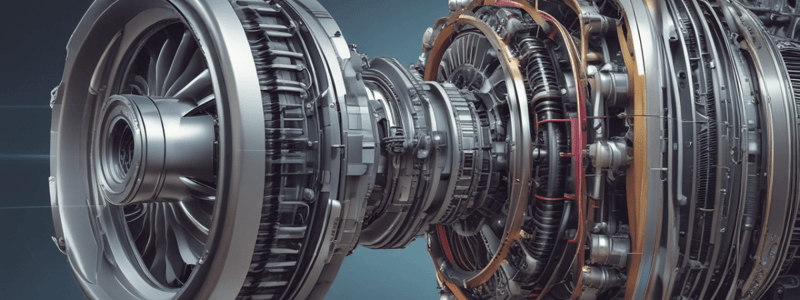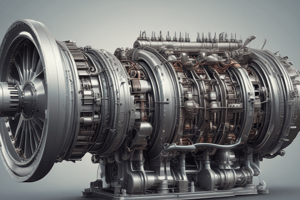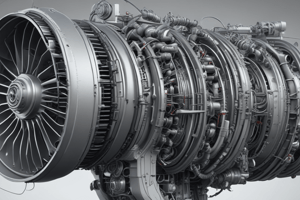Podcast
Questions and Answers
What is the unit of power in the given formula?
What is the unit of power in the given formula?
- foot-pounds per second
- joules per hour
- newton-meters per minute
- foot-pounds per minute (correct)
What is the formula for power when work is substituted into it?
What is the formula for power when work is substituted into it?
- Power = Force × Velocity
- Power = Force × Distance × Time
- Power = Force × Displacement × Time
- Power = Force × Distance / Time (correct)
What is the unit of distance in the given formula?
What is the unit of distance in the given formula?
- meters
- feet (correct)
- inches
- yards
What is the unit of time in the given formula?
What is the unit of time in the given formula?
What is the alternative formula for power derived from the given formulae?
What is the alternative formula for power derived from the given formulae?
What is the power required to hoist a 2500-lb engine a height of 9 ft in 2 min?
What is the power required to hoist a 2500-lb engine a height of 9 ft in 2 min?
What is the primary contribution of the fan in a turbofan engine?
What is the primary contribution of the fan in a turbofan engine?
What is the main advantage of turbofan engines over turbojet engines?
What is the main advantage of turbofan engines over turbojet engines?
What is the characteristic of turbofan engines that allows them to retain short-field takeoff capability?
What is the characteristic of turbofan engines that allows them to retain short-field takeoff capability?
What is the difference between forward-fan and aft-fan engines?
What is the difference between forward-fan and aft-fan engines?
What happens to the inlet air that passes through a turbofan engine?
What happens to the inlet air that passes through a turbofan engine?
Why are turbofan engines commonly used in commercial airliners?
Why are turbofan engines commonly used in commercial airliners?
What is the relationship between pressure and velocity in a venturi according to Bernoulli's theorem?
What is the relationship between pressure and velocity in a venturi according to Bernoulli's theorem?
What is the significance of Bernoulli's theorem in a jet engine?
What is the significance of Bernoulli's theorem in a jet engine?
What is the total energy of a particle in motion according to Bernoulli's theorem?
What is the total energy of a particle in motion according to Bernoulli's theorem?
What is the sum of static and dynamic pressure in a venturi?
What is the sum of static and dynamic pressure in a venturi?
What are the two forms of energy that describe the propulsive power of a jet engine?
What are the two forms of energy that describe the propulsive power of a jet engine?
What is the purpose of energy in a gas turbine engine?
What is the purpose of energy in a gas turbine engine?
What is the primary source of kinetic energy in an aircraft?
What is the primary source of kinetic energy in an aircraft?
What happens to the kinetic energy of an aircraft when it lands?
What happens to the kinetic energy of an aircraft when it lands?
What is the formula for kinetic energy?
What is the formula for kinetic energy?
What is the law of conservation of energy?
What is the law of conservation of energy?
What is an example of potential energy?
What is an example of potential energy?
What is the thrust of an engine?
What is the thrust of an engine?
What is the primary advantage of turbojet engines in high-altitude operations?
What is the primary advantage of turbojet engines in high-altitude operations?
What is the primary purpose of the compressor in a turbojet engine?
What is the primary purpose of the compressor in a turbojet engine?
What is the main difference between a turbojet engine and a turbofan engine?
What is the main difference between a turbojet engine and a turbofan engine?
What is the result of the heat generated by the burning fuel in a turbojet engine?
What is the result of the heat generated by the burning fuel in a turbojet engine?
What is the primary function of the turbine wheels in a turbojet engine?
What is the primary function of the turbine wheels in a turbojet engine?
At what speed range is the turbojet or turbofan engine most widely used?
At what speed range is the turbojet or turbofan engine most widely used?
Study Notes
Formulae for Power and Work
- Power formula: P = W / t
- Work formula: W = F × D
- Substituting work formula into power formula: P = F × D / t
- Simplified power formula: P = F × v, where v is velocity
Worked Example
- A 2500-lb engine is hoisted 9 ft in 2 min, requiring a certain amount of power
Turbofan Engines
- Turbofan engines have turbojet-type cruise speed capability and short-field take-off capability
- Fans produce 30%–90% of total thrust, depending on bypass ratio
- Nearly all present-day airliners use turbofan engines due to fuel efficiency
- Fan can be mounted to front (forward-fan engine) or back (aft-fan engine) of compressor
Bernoulli's Theorem
- "The total energy of a particle in motion is constant at all points on its path at a steady flow"
- In a venturi, pressure is inversely proportional to velocity
- Significance: basic principle of operation of a jet engine
Potential and Kinetic Energy
- Energy is used to perform useful work in a gas turbine engine
- Potential energy: stored energy due to position (e.g., water behind a dam or fuel)
- Kinetic energy: energy possessed by a body due to its motion
- Kinetic energy formula: KE = 1/2 mv^2, where m is mass and v is velocity
- The thrust of the engine is kinetic energy
Conservation of Energy
- "Energy can neither be created nor destroyed"
- The law of conservation of energy applies to turbojet engines
Turbojet Engines
- Turbojet engines use acceleration of airflow to produce thrust
- Suitable for high-speed, high-altitude operations due to enhanced efficiencies
- Basic operating principles: air enters through inlet duct, is compressed, mixed with fuel, and ignited, then exits engine at high velocity, producing thrust
Studying That Suits You
Use AI to generate personalized quizzes and flashcards to suit your learning preferences.
Related Documents
Description
This quiz covers the formulas for power and work in the context of a gas turbine engine, specifically for CASA Part 66 training. It involves substituting the work formula into the power formula.




